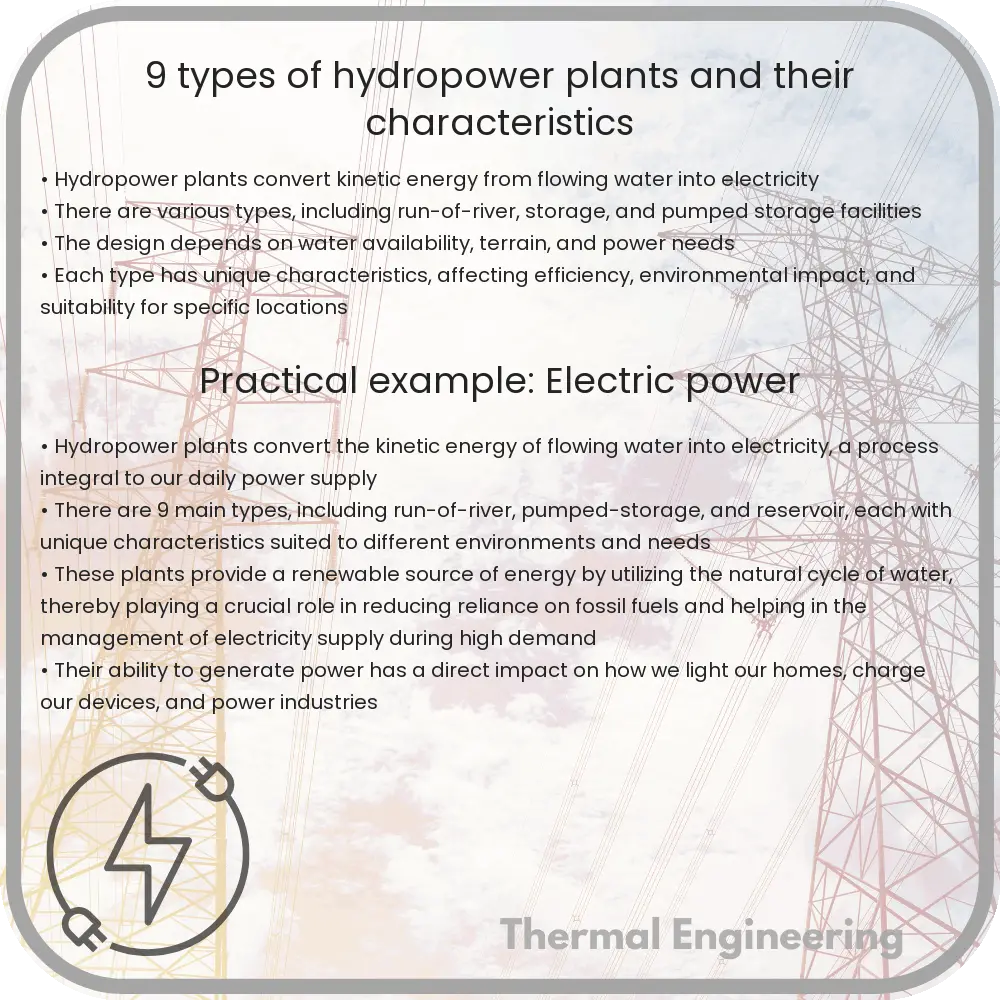Learn about the diverse types of hydropower plants used globally to harness renewable energy from water sources.

Introduction to Hydropower Plants
Hydropower plants harness the energy of flowing water to generate electricity, making them a crucial component of renewable energy landscapes around the world. They come in a variety of forms, each designed to fit specific environmental and geographical requirements. In this article, we’ll explore nine common types of hydropower plants and outline their unique characteristics and applications.
1. Impoundment Hydropower Plant
This type of plant is one of the most common and utilizes a dam to store river water in a reservoir. Electricity is generated when the water released from the reservoir flows through turbines, converting the water’s potential energy into mechanical, and subsequently, electrical energy. This method allows for electricity to be produced on demand.
2. Diversion Hydropower Plant (Run-of-River)
Diversion, or run-of-river, hydropower plants direct a portion of a river through a canal or penstock and do not generally require a large dam. They are dependent on river flow and are less disruptive to the environment compared to large-scale hydropower plants. However, their energy output can fluctuate greatly with the seasonal river flow.
3. Pumped Storage Hydropower Plant
Pumped storage plants are a type of hydroelectric storage system that works on a dual reservoir model. During periods of low energy demand, electricity is used to pump water from a lower reservoir to an upper one. When demand is high, water is released back into the lower reservoir through a turbine to generate electricity quickly. This method is excellent for balancing load and storing energy.
4. Offshore Hydropower
Offshore hydropower generates electricity from tidal movements or the flow of water in rivers out into oceans. Unlike traditional tidal energy, which often uses the movement of water during tides, offshore hydropower focuses on continuous river or ocean currents, expanding the potential locations and improving efficiency.
5. Tidal Hydropower Plant
Tidal plants utilize the movement of the tides to generate energy. There are two main types: tidal stream systems that capture the energy of fast-flowing bodies of water using turbines, and tidal barrage systems that utilize differences in water levels, often through dams, to generate energy. Tidal hydropower is predictable and highly efficient.
6. Instream Technology
Instream energy systems, sometimes known as hydrokinetic energy, generate power from the kinetic energy of flowing water in rivers or streams without the need for significant structural barriers like dams. This technology minimizes ecological impacts and is considered advantageous for its low cost and deployability.
7. Pressure Retarded Osmosis (PRO) Hydropower Plant
PRO plants use a semipermeable membrane to generate energy through the osmotic pressure differential between freshwater and saltwater. This type of power plant is mostly experimental and represents a cutting-edge approach to energy generation using the natural properties of water.
8. Underground Hydropower Plant
These plants are constructed underground, particularly in mountainous areas, to minimize environmental impact and preserve the landscape. The plant infrastructure, including tunnels and shafts, utilizes natural water pressure due to elevation differences to generate power efficiently.
9. Small Scale Hydropower Plant
Small scale hydropower plants are typically used for local applications, often in remote areas where larger grids are not accessible. They can provide a reliable and continuous source of electricity for small communities, and their environmental footprint is usually minimal.
Conclusion
The variety of hydropower plants demonstrates the flexibility of water as a renewable energy source. From massive dam-based facilities to minimalistic instream technologies, these plants can be tailored to meet the energy needs of different environments and communities, making hydropower a cornerstone of sustainable electricity production worldwide.